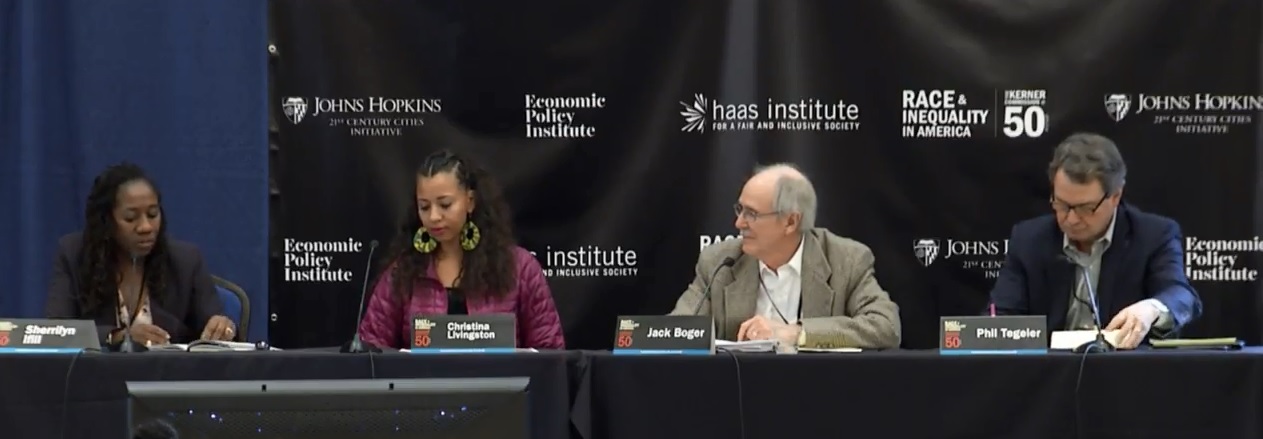
April 5, 2018
By Yuyan Pu, Social Policy Intern, 21st Century Cities Initiative
In the Summer of 1967, the Kerner Commission was organized by President Lyndon B. Johnson to investigate that year’s race riots that broke out across American cities. The Commission was guided by the following questions: “What happened? Why did it happen? What can be done to prevent it from happening again and again?”
The answers to these questions came in the Commission’s conclusive report. It indicted white society of systematically depriving black Americans of economic opportunity and segregating them into poor, crowded neighborhoods that perpetuated significant housing, education, employment, and wealth gaps between white and black America. The report recommended major government action to reform such inequalities.
On the 50th anniversary of the report’s release, the 21st Century Cities Initiative joined the Haas Institute for a Fair and Inclusive Society at the University of California, Berkeley and the Economic Policy Institute in hosting a conference that explored the legacy, successes, and failures of the Commission, and envisioned what a contemporary Kerner report would say about today’s lingering issues on race, segregation, and inequality.
The Kerner report laid out three directions for the country in addressing racial inequality: do nothing, create separate but equal societies, or promote integration. Like the authors of the report, the final panel of our event, titled: Remedies, Big and Small focused on the latter of these options.
Sherrilyn Ifill, President and Director-Counsel of the NAACP Legal Defense Fund moderated the panel, which also included Christina Livingston, Executive Director of the Alliance of Californians for Community Empowerment; Jack Boger, former Dean of the University of North Carolina’s Law School; and Philip Tegeler, President & Executive Director of the Poverty & Race Research Action Council.
Together, this panel explored ideas to promote racial integration and close racial gaps that have gone largely unchanged over the last 50 years. I was especially intrigued by three ideas discussed by the panel.
The first idea seeks to promote mixed-income and mixed-race neighborhoods through incentives in the tax code. Boger suggested tying the mortgage interest deduction enjoyed by homeowners to the inclusion of people of color in segregated neighborhoods. If a segregated neighborhood’s racial diversity doesn’t improve in five years, then homeowners in the neighborhood would forfeit a percentage of their mortgage interest deductions. The forfeited percentage would continue to increase until all deductions disappear and could only be restored as the neighborhood diversifies. Boger argued that such an incentive would encourage people to seek out integrated neighborhoods. Watch below to hear Boger explain the idea.
The second idea creates incentives through federal funding to localities. Tegeler argued that federal block grants that are largely distributed based on formula move to a competitive grant model scored based on local policy approaches intended to promote equity. If states or localities wish to receive federal education funds, for example, they must then pursue school policies that promote de-segregation and integration. Watch below to hear Tegeler explain the idea.
The third idea is to create incentives for parents to send their children to more integrated high schools. To cultivate this preference, Boger suggested that college admissions offices could look favorably on students who attend racially and socioeconomically diverse high schools, increasing their chances of acceptance into the university. Such a policy would incentivize parents to send their children to diverse schools. Watch below to hear Boger explain the idea.
While the first two of these policy ideas require federal action, an unlikely outcome in the current political climate, there are versions of these ideas that could be enacted at the state or local level. For example, states or localities could offer property tax exemptions to encourage integration. Property owners in neighborhoods that achieve improvements to racial integration would receive partial-to-full property tax exemptions, depending on the extent of integration. With regards to grants, states and locales could tie their own grant programs to outcomes that promote equity. Such experimentation at the state and local level can lead to adoption and improvement by other states, and eventually federal level policy.
Ultimately, in order to achieve bold and progressive action at the federal level, the panel discussed the need for building new political coalitions that could push for such policy reform. For example, overlapping economic interests of white working class voters and black, Latino, and other working class voters of color could bring these groups together in a united front for expanding economic opportunity for all workers and middle class families.
The panel agreed that we can’t overcome racial prejudices by simply ignoring race. As Livingston pointed out, people of color need to be the center of both action and discussion in order to succeed in integrating America. She posited that when race is not included in the discussion of economic remedies then access to economic resources will be limited to white Americans, leaving our country in a continued state of being separate and unequal.
Watch the full Remedies Panel here.
Watch all the Kerner Conference videos here.

